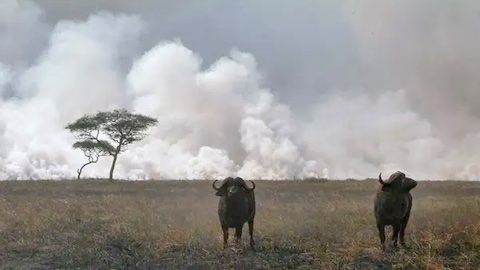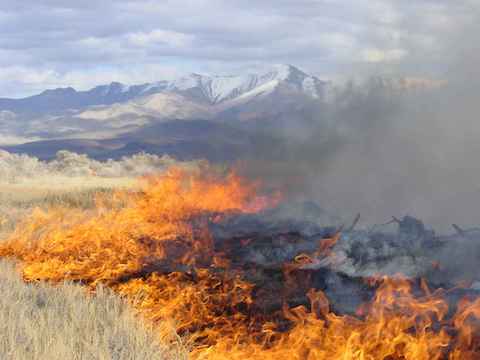
Credit: Gareth Catt/Kanyirninpa Jukurrpa
Monkeys make tools. Birds build houses. And ants grow agriculture.
Bees live in complex societies, and many creatures use basic language to communicate.
It could be argued that the biggest differentiator of humans from other animals is that we have harnessed energy—first and still foremost in the form of fire.
Fire kept us warm, allowing early humans and our ancestors to spread into harsher climates. It helped us hunt, then gave us the ability to cook. We gathered around the fire at night, which helped us develop language, share stories and build cultures and religion.
Scientists have theorized that fire was so instrumental to human development, we could not have evolved without it.
Cooking with fire broke down tough animal protein and plant matter, making things that may not have been edible now digestible and more nutritious.
This may have given prehumans the calorie and protein surplus to develop bigger brains, to build stronger communities, to spend more time raising children and passing knowledge to them.
Scientists have found evidence of hearths, places to cook and gather, from as far back as one million years ago.
Four-hundred thousand years ago, hominids may have realized they could strike flints to make sparks, which made fire portable.
And today, three billion people still get most of their energy from burning wood and biomass.
Humans make fire, but fire also made humans.
Background
Synopsis: Previously we talked about the delicate oxygen balance mediated by the interplay of oxygen-producing photosynthesis and oxygen-consuming fire that made Earth habitable for large terrestrial animals. But researchers believe that fire also played a remarkable role in the evolution of hominids and humans. The leap that enabled our ancestors to control fire may be one of our most important technological advances. Cooked food is easier to digest, providing extra protein that supported increased brain growth critical to human development. Cooked food also takes less time to chew, freeing up time for other pursuits.
- While atmospheric oxygen levels varied from 13% to 30% over the past 450 million years, they have remained pretty constant since 55 million years ago.
- In the Cenozoic Era, oxygen levels declined to around 21% during the Eocene Epoch and have remained fairly steady for the 55 million years since. Today’s atmospheric oxygen level is 20.9%
- Six to seven million years ago grasslands expanded, providing additional tinder for fires. Without fire, these savannas would be overtaken by scrub and forest. Frequent wildfires produced a warmer climate conducive to drying fuel and further fire development—all it would take to start is a lightning strike.
- Researchers don’t have a very good handle on the timing of humankind’s history with fire.
- Evidence of deliberate hominid or human interaction with fire is difficult to separate from natural events.
- Scientists believe this interaction developed at different times in different regions through a series of predictable stages.

Credit: Colin Beale, The Conversation
- Hominids first experienced natural fires on the savannas where they lived and hunted.
- At first, like other animals, hominids may have run from it, but later they began to understand it by watching the flames and following the fire.
- Hominins (hominids of the genus Homo) learned to hunt animals fleeing from wildfires and to collect scorched animals and plants after the flames had passed.
- They discovered that they could interact safely with fire and benefit from it.
- Next our ancestors began to recognize additional benefits of fire like warmth, light and protection from predators. Smoke even protected them from insects.
- They could cook their food to make it easier to chew and digest, freeing up time for additional activities.
- Hearths provided a gathering place for social interaction and may have been important to the development of language.
- In fact, some researchers have hypothesized that more than one million years ago, cooking food enabled higher caloric intake and digestive efficiency that changed hominin physiology, producing a shorter, more efficient digestive tract and freeing up energy for brain growth.

Credit: Ötzi the Iceman Exhibit, South Tyrol Museum of Archaeology
- Hominins learned to capture embers from forest fires, conserving them by adding slow-burning fuel like dung and containing them in vessels for transport to the hearths in their camps. These practices are still in use by some cultures today.
- It is hard to tell when the earliest deliberate manipulation of fire may have occurred, because open-air hearths are difficult to distinguish from natural fires.
- Some very old sites identified with charcoal and burned bones may be remains of abandoned hominin camps that were burned in a later wildfire.
- Inhabited for at least 1.9 million years, archaeological sites with fire-marked red-orange soils along the banks of Lake Turkana in northeastern Kenya have recently produced new clues. High polycyclic aromatic hydrocarbon measurements (produced from burning wood) occur in proximity to suspected hearths but are absent outside of archaeological sites, indicating that these ancient fires must have been contained. Further work on the timing of types of fire use in the region is ongoing.
- The most-reliable evidence of the intentional use of fire comes from ancient hearths in caves, where natural fire is less likely to occur.
- Qesem Cave in Israel provides clear evidence of repeated use of a hearth for roasting meat between 300,000 and 400,000 years ago.
- Wonderwerk Cave in South Africa’s Northern Cape Province was inhabited for at least 2 million years by hominids and humans. It contains evidence of hearths that could be as much as one million years old, along with tools characteristic of Homo erectus, a hominin that lived from 1.8 million to 200,000 years ago.
- It is hard to tell when the earliest deliberate manipulation of fire may have occurred, because open-air hearths are difficult to distinguish from natural fires.

Credit: The Portable Antiquities Scheme/The Trustees of the British Museum, CC BY-SA 4.0, via Wikimedia Commons
- The next major technological leap occurred when our ancestors figured out how to start a fire without the use of transported embers.
- Use of flint may have occurred as much as 400,000 years ago, but reliable evidence for the use of flint to start fires is only about 50,000 years old.
- Research shows that about 50,000 years ago, groups of Neanderthals in Europe used their flint hand axes to start fires by striking them along their knapped faces with pyrite, creating characteristic C-shaped marks on the flint.
- Although these findings suggest Neanderthals could start fires, recent studies of sediments flooring middle Paleolithic Neanderthal caves in France suggest that may not have been the case for all groups.
- Neanderthals consistently used hearths in the French caves through warmer periods when they could collect embers from natural fires.
- However, during later cold periods from 70,000–40,000 years ago, cave sediments showed signs of occupation but no evidence of fire.
- Even if wood was unavailable, bones of large Pleistocene animals could fuel fires, but there was no evidence that any bones were burned there.
- This particular group of Neanderthals did not appear to have the ability to make fire during Pleistocene glaciations. Generations of occupants in the cave must have gone without ever seeing fire in the depths of the ice age.
- The last technological step came about 7,000 years ago, when humans began to control and use fire for agricultural purposes, a practice that continues today.
- Like their ancestors, modern farmers use controlled burns to clear fields and to improve soil all over the world.
- Low-intensity, precisely timed controlled burning of undergrowth has been used throughout history as a tool to prevent uncontrolled wildfire by many Aboriginal groups. Their logical, practical methods are being adopted globally.

Credit: US Fish and Wildlife Service (This photo was taken by FWS firefighter John Wood, winning first place in the 2003 USFWS Fire Management Today annual photo contest.)

